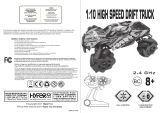
19
Connectivity
Recorded video footage and photos can be copied to a computer using the USB
cable provided or—if your computer has an appropriate card reader—directly
from the Micro SD card.
Connecting to a Windows PC by USB Cable
1. Connect the camera to your PC using the USB cable. The camera screen will
display a USB logo and the LED status indicator will blink red.
2. Your PC’s operating system may be setup to open new devices automatically,
if not, open My Computer.
3. Your PC should recognise the camera as a removable device—look for DRIFT
CARD in the list of all devices and open.
4. Open the DCIM folder, inside you will find the 100DRIFT folder, which
contains all the files saved on the memory card by the camera.
! If there are a very large numbers of files, there will be multiple folders
(100DRIFT, 101DRIFT, etc).
5. Copy the desired files to your PC.
Connecting to a Mac by USB Cable
1. Connect the camera to your Mac using the USB cable. The camera screen will
display a USB logo and the LED status indicator will blink red.
2. Your Mac’s operating system may be setup to open new devices automatically,
if not, open a new Finder window.
3. Your Mac should recognise the camera as a removable device—look for DRIFT
CARD in the list of devices and open.
4. Open the DCIM folder—inside, you will find the 100DRIFT folder which
contains all the files saved on the memory card by the camera.
! If there are a very large numbers of files, there will be multiple folders
(100DRIFT, 101DRIFT, etc).
5. Copy the desired files to your Mac.
Connecting the Camera to a TV
1. While the camera is turned o, connect it to your TV using a Mini HDMI type
C cable (not included).
2. Power on the camera.
3. Once booted up, the image usually displayed on the camera’s LCD screen will
instead be displayed directly on your TV, and the sound will come out of the
TV speakers.
4. Press MENU to cycle through camera modes while connected to a TV.
Connecting to a Wi-Fi Device
1. Set the Wi-Fi network name and turn on the Wi-Fi as per p14.
2. On your mobile device navigate to your Wi-Fi network settings. For most
devices, this will be found in SETTINGS>Wi-Fi. Search for the network name
‘Ghost S XXX’ where XXX is the three number digit you assigned when setting
up the network name on your camera.
3. Select the network found in step 2 to connect your device and your camera.
Manual HDMI Out
The Ghost-S will automatically connect via HDMI to an HD ready TV. However,
it is also capable of manually setting the HDMI out to either 1080p, 1080i or 720p.
These can be set to 60, 50, 30 or 25 frames per second for the progressive
modes, and 60 or 50 HZ for the interlaced modes.
Playing Video on a Computer
Some computers may not have the
correct codecs required for video
playback and editing.
If you experience diculties playing
video recorded with your camera, you
can download VLC media player for
free from www.videolan.org.
If you are experiencing diculties
editing video or do not wish to use
VLC player for playback, you will need
to download and install a codec pack.
The FFDshow codec pack can be
downloaded from www.free-codecs.
com/FFDshow_download.htm.
Recommended System Requirements
To smoothly view and edit HD video,
powerful hardware is required:
Windows
• 2nd Generation Intel® Core™ or
AMD equivalent, Intel® Core™ i7
recommended.
• Minimum 2GB of RAM (recommend
4GB and up).
• Graphics card comparable to
NVIDIA GeForce 600 or AMD
Radeon HD6000 and up.
• Microsoft Windows Vista or
Windows 7 or later.
Mac
• 2nd Generation Intel® Core™ or
AMD equivalent, Intel® Core™ i7
recommended.
• Minimum 2GB of RAM (recommend
4GB and up).
• Graphics card comparable to
NVIDIA GeForce 600 or AMD
Radeon HD6000 and up.
• Mac OS X v10.5 or later.






















